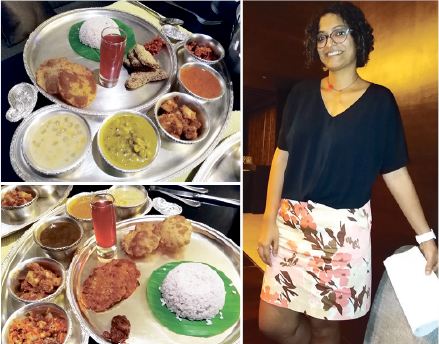‘Goan Stories’ at Taj Vivanta for Shravan-ka-Mahina… both vegetarian and sea food platters were available with many intrigued by the vegetarian recipes of niche Saraswat cuisine in Goa, such things as moogache gathi, udaamethi, pineapple or hogplum karam, vodyachi kismoor, ambyache lonche in mustard oil, all to be relished with goenche sheet and wade (puri). In pic (right) consultant cuisine curator Shubra Shankwalkar
By Tara Narayan
Eating is Fun / Eating is Yuck! – A variety food column
SHRAVAN ka mahina is coming to a close and I though with panic that not once have I refreshed my memory and palate with the monsoon time delights of Goa’s Saraswat cuisine! Delights like my favourite moogachyo ghathi, khatkathe, ambadyachi udhamethi, ananas karam, nirpansache kappam, …etc. Well, I found them at the Taj Vivanta’s ‘Goan Stories’ — and met the lovely Shubhra Shanwalker who’s the consultant executing the Saraswat cuisine recipes.
They had both seafood and vegetarian thali meals. It is the veggie delights of Saraswat cooking which are hard to find even in Goan restaurants, that’s because this is a niche home cuisine. Long ago I must thank my friend Anjali Walawalkar who introduced me to the community’s cooking.
The meal came on a mango motif white silver platter with half-a-dozen katori brimming over with the day’s menu…ah, the moogache ghathi was savoury and soul satisfying, as was the ambadyache udhamethi to be laced with perfectly cooked “Goenche sheeth” (Goan red rice) and slowly relished. Alongside was finely diced mango lonche (pickle)aromatic with mustard oil and a hing high; yes, said Shubhra who was around, their Saraswat cooking does engage with pure mustard oil in pickles and some of the dishes (perhaps a memory of the community’s via Bengal journey to Goa or so I understand). All Brahmins are related in some way or another!
Came the hot fried crisp wade (puri) and one crunched into them neat or tucked some vadiyachi kismur into them and enjoyed. Vaddyo… that’s the popular sun-dried ashgourd nuggets which come in handy rainy season, just roast fry them and crumble them into the familiar kismur, or add them to a vegetable dish for flavour. Nirpansache fodi is crisply rava fried appetizer and the “futti kadi” in a slender shot glass was pretty pale kokum tival which I could pour on the rocks and enjoy by itself! It had a mystery hint of something I couldn’t identify but absolutely fell for. A sharp hint of Shankar Chaap hing maybe but it was delicious. Tival is really lightly flavoured kokum water austerely sweet or sour. The sweet sherbat-styled ones may be flavoured with bit cardamom; but it’s the sour savoury ones which can seduce the palate more…they may come whispering green chili, green coriander, green curry leaves, thymol or ajwain seeds, garlic, ginger, etc. These days they are doing a lot of things with kokum fresh fruit or salted peels — turning them into chutney, chatpat snacky peels…I chop a few peels and toss them in my ladies finger sabzi garnished or not garnished with fresh coconut. Nice, very nice.
But to continue with my Goan Stories outing, friends with us had ordered the sea food Saraswat thali – the menu here was of sungtache hooman, sungtache danger, vade, sungtachi kishmor, sungtache lonche, ananasachi karam, solachi kadi, futti kadi, goenche sheeth and “Goan dessert” was mangane — with big translucent sabudana in it. A true blue Saraswat “mangane” would not have “sabu dana” in it I said! But that’s because I don’t care for “sabudana” or sago seeds, balls of tapioca flour — a big favourite in the Shravan ka mahina fasting menu. They are scrumptious in a well-made sabudana khichdi though, when all the seeds are soaked and drained well, and cooked through till translucent and redolent of green chili, cumin seed, laced with lots of freshly made peanut crumble).
WELL, a meal like that can last me till the next day and for some reason it left me burping, wonder what did it! Perhaps it was a bit of a heavyweight combo of a meal and I should have left the ambadyachi uddamethi alone — it was too rich for me. But the sour oval ambade or hog plums in the gravy were irresistible and perfect to suck the juice from. Hog plums are interestingly complex, they come in small tender ovals or round tennis ball size — can be lightly skinned, grated and crushed into a salad, relish or chutney or turned into a drink. Can be very palate refreshing.
In Saraswat cuisine hog plums enjoy a special status in uddamethi gravy, but sometimes they come in ambadyocho karam (more like a relish but lightly spiced up). The ambadyocho or ananas sasav/karam recipes have sour or sour-sweet notes in them to die or live for. I can make a meal of them stuffed in a real good fresh kunyachye poie (baked in an old-fashioned wood fired oven)!
(Sigh) Outside a Goan 5-star hotel or resort one may not find a Saraswat meal for love or for money. Of course, if you have Saraswat friends, it’s a different story. With Chovoth or Ganesh Chaturthi here, some of the festive fever is building up these days and I do wish some of the Hindu speciality restaurants would offer some of the Saraswat favourites to buy home. Must ask Shubhra to share some recipes here, so keep watching this space, okay.
I don’t know why this affair was called a Goan Saraswat Pop-up but I guess it means it was temporary festival and now over. To be replaced with something else perhaps, you should see the groups of women who come for these festival offer meal deals, albeit in 5-star comfort and service. Women rarely treat themselves so I don’t mind! At the Taj Vivanta’s Caramel they’ve still got choco gelato but I’m not going there any day soon. So excuse me, please.
